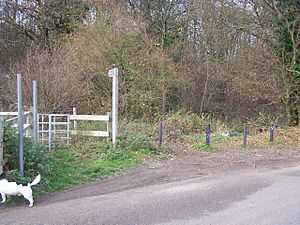Great Crabbles Wood facts for kids
| Site of Special Scientific Interest | |
 |
|
| Area of Search | Kent |
|---|---|
| Interest | Biological |
| Area | 33.0 hectares (82 acres) |
| Notification | 1984 |
| Location map | Magic Map |
Great Crabbles Wood is a really special place for nature. It covers about 33-hectare (82-acre) of land, which is like 46 football fields! This amazing woodland is located north-west of Rochester in Kent, England.
It's officially known as a Site of Special Scientific Interest (SSSI). This means it's a protected area because it has rare plants or animals, or important geological features. Great Crabbles Wood is protected for its unique plant life.
Exploring Great Crabbles Wood
Great Crabbles Wood is mostly a type of forest called "mixed coppice." This is a traditional way of managing woodlands. It involves cutting down trees close to the ground so they can grow back many times. This creates lots of different habitats for plants and animals.
Trees and Plants
The most common trees you'll find here are sweet chestnut and oak trees. The sweet chestnut trees are often part of the coppice system. The oak trees are usually left to grow taller, standing above the coppiced trees.
This wood is also home to some very rare and beautiful flowers. Keep an eye out for:
- Lady orchid
- Man orchid
- Bird's nest orchid
- White helleborine
- Wild liquorice
These plants are quite unusual and need special conditions to grow. Their presence makes Great Crabbles Wood an important place for plant conservation.
Visiting the Wood
You can explore parts of Great Crabbles Wood! There are public footpaths that cross through the woodland. These paths allow visitors to enjoy the natural beauty and discover the amazing plants and trees found here. It's a great spot for a walk and to connect with nature.
Why is it a SSSI?
Great Crabbles Wood was officially made a Site of Special Scientific Interest in 1984. This protection helps to make sure that its unique plant life and woodland habitat are kept safe for the future. It means that the area is managed carefully to help these rare species thrive.

